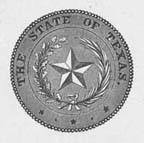
State of Texas Seal
Austin, State Printing Office, 1890.
Department of Agriculture Insurance, Statistics and History, Geological Survey of Texas
E. T. DUMBLE, State Geologist. BULLETIN No.2.
The population in 1890 was 10,00, in 1898 the population was 18,627, and, in 1899 rose to 20,523.
El Paso became the county seat in 1883 and reached a population of more than
10,000 by 1890. As El Paso became a western boomtown, it also became "Six
Shooter Capital" and "Sin City," where scores of saloons, dance
halls, gambling establishments, and houses of prostitution lined the main streets.
At first the city fathers exploited the town's evil reputation by permitting
vice for a price, but in time the more farsighted began to insist that El Paso's
future might be in jeopardy if vice and crime were not brought under a
measure of control. In the 1890s reform-minded citizens conducted a campaign
to curb El Paso's most visible forms of vice and lawlessness, and in 1905 the
city finally enacted ordinances closing houses of gambling and prostitution.
From The
Handbook of Texas Online
The El Paso Symphony Orchestra began in 1893.

State of Texas Seal
Austin, State Printing Office, 1890.
Department of Agriculture Insurance, Statistics and History, Geological Survey
of Texas
E. T. DUMBLE, State Geologist. BULLETIN No.2.
A PRELIMINARY REPORT ON THE SOILS AND WATERS OF THE UPPER RIO GRANDE AND PECOS VALLEYS IN TEXAS.
By H. H. Harrington
Professor of Chemistry and Mineralogy, Agricultural and Mechanical College of
Texas.
"SOILS AND WATERS OF THE UPPER RIO GRANDE VALLEY IN TEXAS.
The investigation into the character of the soils of the upper Rio Grande Valley
as planned,
consisted of a personal examination of that part of El Paso County adjacent
to the Rio Grande
from El Paso to a line below the site of Fort Quitman, for the purpose of ascertaining
the character of soils and of the water supply, with especial regard to their
capacity and
suitability for, irrigation.
The scope of country investigated is some eighty miles in length and from two
to six miles
in width, varying with the breadth of the valley, upon the Texas side of the
Rio Grande,
and having an average width of about three miles.
For this entire length the valley is either traversed or skirted by the G.
H. & S. A. R. R.
and the T.& P. R. R., these railways using the same track from El Paso to
Sierra Blanca,
ninety miles southeast.
For about thirty miles below El Paso the greater part of the valley is now under cultivation.
In many instances the orchards and vineyards are brought up to the highest
state of perfection,
rivaling in beauty and value those of the Pacific Slope. Many varieties of grapes
are grown in the
most satisfactory manner. Pears, peaches, apples, and plums are also found in
many different orchards.
Vegetables of almost every variety and melons of different kinds give the most
satisfactory returns
to the market gardener. Of the farm crops proper, corn, oats, wheat, rye, and
alfalfa seem to be the
most important. Alfalfa is grown in great quantity and, as represented by responsible
and prominent
farmers in the valley, very profitably; from two to four cuttings are made during
each season, and
from two to three tons to the acre are produced at each cutting, the value of
which is from ten to
fifteen dollars per ton.
These variations in the quantity raised are dependent almost entirely on the
supply of water for irrigation.
The supply of irrigating water as managed at present is entirely inadequate
to meet the demands of the valley,
or even to properly supply that portion of it now under cultivation. In many
instances a crop is entirely lost from a want of a supply of water at the proper
time, and often water is obtained too late to give anything like satisfactory
results. In consequence of this and of the class of farm laborers employed,
farming proper is very improperly managed and conducted.
Most of the Americans living in the valley give their attention to viticulture, orchards, or market."